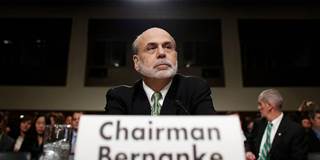Are independent central banks willing to force society to sacrifice growth in order to preserve financial stability? That is the fundamental question that must be answered after a decade of quantitative easing.
NEW HAVEN – November 2018 will mark the tenth anniversary of quantitative easing (QE) — undoubtedly the boldest policy experiment in the modern history of central banking. The only thing comparable to QE was the US Federal Reserve’s anti-inflation campaign of 1979-1980, orchestrated by the Fed’s then-chair, Paul Volcker. But that earlier effort entailed a major adjustment in interest rates via conventional monetary policy. By contrast, the Fed’s QE balance-sheet adjustments were unconventional and, therefore, untested from the start.
The American Enterprise Institute recently held a symposium to mark this important milestone, featuring QE’s architect, Ben Bernanke. What follows are some comments I offered in an accompanying panel session that focused on lessons learned from QE.
The most important lesson pertains to traction — the link between Fed policy and its congressionally mandated objectives of maximum employment and price stability. On this count, the verdict on QE is mixed: The first tranche (QE1) was very successful in arresting a wrenching financial crisis in 2009. But the subsequent rounds (QE2 and QE3) were far less effective. The Fed mistakenly believed that what worked during the crisis would work equally well afterwards.

NEW HAVEN – November 2018 will mark the tenth anniversary of quantitative easing (QE) — undoubtedly the boldest policy experiment in the modern history of central banking. The only thing comparable to QE was the US Federal Reserve’s anti-inflation campaign of 1979-1980, orchestrated by the Fed’s then-chair, Paul Volcker. But that earlier effort entailed a major adjustment in interest rates via conventional monetary policy. By contrast, the Fed’s QE balance-sheet adjustments were unconventional and, therefore, untested from the start.
The American Enterprise Institute recently held a symposium to mark this important milestone, featuring QE’s architect, Ben Bernanke. What follows are some comments I offered in an accompanying panel session that focused on lessons learned from QE.
The most important lesson pertains to traction — the link between Fed policy and its congressionally mandated objectives of maximum employment and price stability. On this count, the verdict on QE is mixed: The first tranche (QE1) was very successful in arresting a wrenching financial crisis in 2009. But the subsequent rounds (QE2 and QE3) were far less effective. The Fed mistakenly believed that what worked during the crisis would work equally well afterwards.